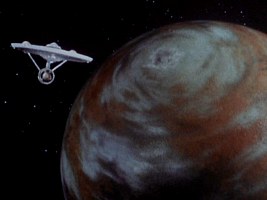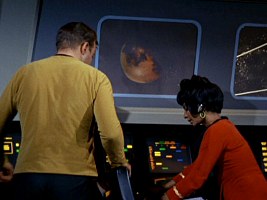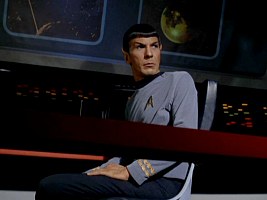Planets in TOS and TOS Remastered - Part 1
by Jörg Hillebrand, Anthony Pascale and Bernd Schneider, with comments from Max Gabl and Mike Okuda
General NotesTalos IVPlanet 1EarthGuardian PlanetPlanet 2Planet 3Sigma DraconisExcalbiaAsteroidNew in TOS-ROther Celestial Objects
 In the three seasons of Star Trek: The Original Series (TOS) we could see a variety of planets in space, with or without the
Enterprise in orbit, on average almost one per episode. In order to let them appear as realistic as possible with the techniques of the
1960s, the planets are usually visibly spinning, even though they are typically shown just for seconds at a time, hereby exploiting the
advantage of a three-dimensional globe over a simple photo. Also, the scenes were filmed from various angles to add diversity, although
the ship's positions in orbit may not always be consistent in an episode.
In the three seasons of Star Trek: The Original Series (TOS) we could see a variety of planets in space, with or without the
Enterprise in orbit, on average almost one per episode. In order to let them appear as realistic as possible with the techniques of the
1960s, the planets are usually visibly spinning, even though they are typically shown just for seconds at a time, hereby exploiting the
advantage of a three-dimensional globe over a simple photo. Also, the scenes were filmed from various angles to add diversity, although
the ship's positions in orbit may not always be consistent in an episode.
At least one of these planet models (referred to by us as planet 1) was surprisingly detailed as we can see on a photo. But like with shots of the Enterprise, the filming techniques and the film transfer of the 1960s didn't allow a better resolution.
It looks like there used to be no more than five distinct planet models that were modified through color overlays to represent different planets. In several cases no changes at all were made, and stock footage served to represent a new planet.
Thanks to CGI, these shortcomings were eventually corrected in the remastered version of Star Trek (TOS-R), produced by CBS Digital from 2006 to 2008. In TOS-R every planet has a distinctive appearance, even though the consequence is that few of them still look as they did in TOS. Overall, the variety of planet surfaces has considerably increased, while the color variations are not as remarkable as in TOS any longer, owing to the use of more natural hues in TOS-R.
Our article has two purposes: It identifies the planet models that can be seen in TOS in the order of their appearance and a couple of other celestial objects, something that has never been done systematically before. All headings and other classifications refer to the TOS versions of the planets. We then contrast these planets with the new ones of TOS-R. Note that we didn't bother to match the perspectives of our TOS and the TOS-R screen caps because in the exactly corresponding shots in the episodes they often don't match either. So we picked TOS screen caps that show identical planets from as many different angles as possible for the sake of diversity, and TOS-R caps that provide a good look at the new planet surface.
Mike Okuda has been a co-producer of TOS-R. Max Gabl created most of the planets and matte paintings for the show. We have been able to gather many comments from the two on what they changed and why.
General Notes
All planets to be re-imagined for TOS-R were specified in a way to comply with existing location and planet set shots before the task was given to the artists.
Max Gabl: "Usually Mike [Okuda] and Dave [Rossi] approached me with the basic concept of the planet. Something like, 'earthlike, with large dark mountain ranges, pink skies, poles, swirly type of clouds, 30 percent oceans.' These preconditions came from the shots in the corresponding episode. If we could see a red sky and a sandy soil, the planet had to look like that from outside too. Aside from these specifications, I enjoyed almost absolute freedom. Naturally, there were also the inevitable last-minute revisions. It was very pleasant to work with Mike Okuda. He is a great artist in his field and a nice person. He created almost all graphics for Star Trek and was the architect of many of the buildings. 'He's got the Star Trek look down to a science'."
Once Max Gabl had the basic parameters of a planet, it was up to him to get its look right.
Max Gabl: "First I was given instructions for the planets, including surface type, cloud type, atmosphere color, percentage of water bodies, special features, etc. Then I asked my own set of questions mostly on scale, light/type preferences, etc. Based on the specifications I received, I could determine the feasibility of the assignment. E.g.: a red atmosphere over a lush, green canopy of plants, as seen from space, would translate into a brownish canopy (also imagine what the red will do to the blue oceans underneath). This could confuse the viewer who just saw a shot filmed on a stage with a lush green forest foreground with a red stage sky behind, not affecting the greens in the shot.
Add to the assignment, that the producer wants to see a hint of the tall buildings on the planet from space. How tall would the 1000 feet buildings have to be to be visible from space? 100 miles tall maybe? That would make the planet look small. So at the end it was about what was possible without sacrificing realism, so the viewer could 'live' in the image. I projected the textures onto 3D geometry, which was the fastest solution due to the fact, that painting a sphere from scratch, with the constantly mathematically correct shifting of perspective and falloff, proves to be quite a task, and sometimes weeks of work. A lot of times, I modeled and lit entire scenes in 3D and then painted them over. The average time frame given for the planets though was about 2 days a piece.
Along with the 49 planets I created, there were 33 additional 'on the surface' matte paintings and a few nebulas for TOS-R on my list, some purely 2D and some 3D/2D. And there were other shows on the side to be worked on (btw, I was not involved with the outside Enterprise shots). [...] Niel Wray, our vfx supervisor, contributed some excellent 3D buildings (along with his valuable insights and knowledge of course) to some of the surface matte paintings, by the way."
While new planets were not created from scratch, every one of them went through several design steps.
Max Gabl: "I started with templates from NASA that I manipulated until I had something to work with. Then a lot of 'paint from scratch' was added to the mix. When I'm talking of 'paint from scratch', I mean painting with a pen on a graphics table (Wacom Tablet). Many of the initial textures that I created were later modified (repainted, colored, cloned, etc.) and used for new planets. When I had the textures ready, I projected them onto 3D spheres. I also obtained so-called geo-data for the elevations (mountains & valleys) from geological web sites, and I painted over them and otherwise modified them to be used as so-called bump and displacement maps. This is how the 3-dimensional look of my planets was created. It was much work to harmonize the color textures and the displacement maps. The clouds (all of which are painted) consist of so-called alpha channels that I projected on a second, slightly larger half-transparent sphere. This gives us the illusion of a cloud layer hovering above the planet. Finally I painted over the projections ('fine tuning') once again, in order to eliminate the '3D look' and to add some extra details."
Unlike it was customary in the time of TOS, no footage was simply turned or mirrored to act as a different planet.
Max Gabl: "I recycled textures and displacement maps and rearranged, recolored, repainted them. Mirroring would be too obvious, and a lot of the textures repeat (tile) around the sphere, being obvious too. Most of the times, in TOS-R you see the planets do only a small turning movement..."
The majority of planets of TOS-R was created by CGI artist Max Gabl. The planets not done by him include: M113, Planet Q, Beta III, Organia, Starbase 11 planet (from space), Earth (all appearances), Cestus III, Beta XII-A, Guardian of Forever planet, Amusement Park Planet, Capella IV, Tyree's planet aka Neural, Kelvan, Ekos.
Max Gabl: "Niel Wray [TOS-R VFX supervisor] told me that he used photos of Earth for one or two shots. [...] It looks like some of these planets are based on photos of Earth and of existing planets, blended with textures that are partially derived from my creations. Most of the artists that were working for TOS-R with CBSD are not here any longer. So I can't provide more detailed information on their planets."
Talos IV
The first ever planet visualized for Star Trek is Talos IV in the first pilot movie "The Cage", which later appears in TOS: "The Menagerie, Part II" too. The surface of Talos was created coloring a picture of Earth's Moon and overlaying a cloud pattern. See also at StarTrekHistory.com.
While the Talos-Moon never appeared again as a "live" planet in Star Trek, we can see its picture as set dressing on the Enterprise's bridge in countless TOS and TOS-R episodes.
Planet 1
Planet 1a - brown/red
Planet 1a is characterized by its brown basic color, its rather blurred surface and the elongated cloud stripes that indicate a fast rotation. And really, we can see in brief shots with the Enterprise in orbit that the planet is spinning. Planet 1a begins its life in the second pilot episode, TOS: "Where No Man Has Gone Before". In "The Alternative Factor" Spock says about the planet of that episode: "Iron-silicon base, oxygen-hydrogen atmosphere, largely arid, no discernible life".
The same planet reappears several times in TOS, predominantly in the first season, twice in the second and just once in the third season. We can mostly see it in composite shots with the Enterprise in space, less frequently on the main bridge viewer. Quite possibly all these later incarnations are stock footage that was already shot for TOS: "Where No Man Has Gone Before". While the brightness, contrast and the exact hue is subject to vary, the brownish color remains essentially the same in all following TOS episodes with Planet 1a.
Mike Okuda: "Delta Vega and M-113 were two cases in which I specifically asked for the remastered planets to closely resemble the originals. I would have preferred that Delta Vega be even closer to the original." |
   |
   |
|
   |
|
Max Gabl: "I only did the planet, the rings were added later. I remember putting them into the surface painting though." |
   |
   |
|
   |
|
Max Gabl: "One of the 'juicier' assignments I got, indeed." |
   |
Max Gabl: "I used the Caspian Sea as reference [for the small oceans or lakes], with its green and ultramarine colored regions, if I remember correctly. I was given instructions on color and surface detail, including so and so much of the surface should be water." |
   |
   |
|
Max Gabl: "I don't remember doing a planet for this one, just the mining colony. This was my very first assignment and the planet was done before 'my time' I guess." |
   |
   |
|
   |
|
   |
|
Max Gabl: "Glad you like it! Mike tried to be as accurate as POSSIBLE." |
   |
Planet 1b - blue
This is the very same model as Planet 1a. However, since the script of TOS: "Mudd's Women" called for a windy and cold planet, the available shots of Delta Vega (Planet 1a) were colored bluish for Rigel XII. We can see that the blue color is a modification accomplished by filming the original footage through a blue filter, since the formerly brown/white image has gained an overall blue tint. The bright blue clouds against the very dark blue surface make Planet 1b rather unrealistic. Still, in the blue guise the planet model made a total of six appearances in TOS, five in season 1 and the second appearance as the Starbase 11 planet in "The Menagerie, Part I" in season 2.
   |
|
   |
|
   |
|
   |
|
Max Gabl: "Someone else did this one, but I redid it and changed mainly the night city lights." |
   |
Mike Okuda: "Same thing [refinement due to improved techniques] with the Starbase 11 planet between 'The Menagerie' and 'Court Martial.'" |
   |
Planet 1c - green
The original footage of Planet 1a was modified one more time in the same fashion as with Planet 1b, this time with a green new tint. This green variant Planet 1c appears in two more episodes, giving us a total of 22 appearances of all versions of Planet 1.







 Model of planet 1
Model of planet 1





















